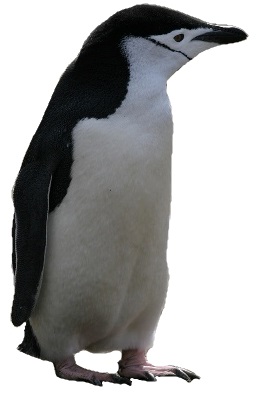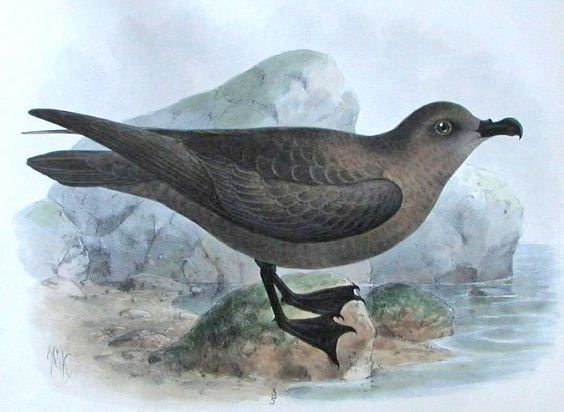|
Phaethontiformes
The Phaethontiformes are an order of birds. They contain one extant family, the tropicbirds (Phaethontidae), and one extinct family Prophaethontidae from the early Cenozoic. Several fossil genera have been described. The tropicbirds were traditionally grouped in the order Pelecaniformes, which contained the pelicans, cormorants and shags, darters, gannets and boobies and frigatebirds; in the Sibley-Ahlquist taxonomy, the Pelecaniformes were united with other groups into a large "Ciconiiformes". More recently this grouping has been found to be massively paraphyletic (missing closer relatives of its distantly related groups) and split again. Microscopic analysis of eggshell structure by Konstantin Mikhailov in 1995 found that the eggshells of tropicbirds lacked the covering of thick microglobular material of other Pelecaniformes. Some early studies in the last decade suggested Phaethontiformes were distantly related to Procellariiformes, but since 2004 they have been pl ... [...More Info...] [...Related Items...] OR: [Wikipedia] [Google] [Baidu] |
Tropicbird
Tropicbirds are a family, Phaethontidae, of tropical pelagic seabirds. They are the sole living representatives of the order Phaethontiformes. For many years they were considered part of the Pelecaniformes, but genetics indicates they are most closely related to the Eurypygiformes. There are three species in one genus, ''Phaethon''. The scientific names are derived from Ancient Greek ''phaethon'', "sun". They have predominantly white plumage with elongated tail feathers and small feeble legs and feet. Taxonomy, systematics and evolution The genus ''Phaethon'' was introduced in 1758 by the Swedish naturalist Carl Linnaeus in 1758 in the tenth edition of his ''Systema Naturae''. The name is from Ancient Greek ''phaethōn'' meaning "sun". The type species was designated as the red-billed tropicbird (''Phaethon aethereus'') by George Robert Gray in 1840. Tropicbirds were traditionally grouped in the order Pelecaniformes, which contained the pelicans, cormorants and shags, darte ... [...More Info...] [...Related Items...] OR: [Wikipedia] [Google] [Baidu] |
Prophaethontidae
Prophaethontidae is an extinct family of Early Paleogene The Paleogene ( ; British English, also spelled Palaeogene or Palæogene; informally Lower Tertiary or Early Tertiary) is a geologic period, geologic period and system that spans 43 million years from the end of the Cretaceous Period million yea ... phaethontiforms that include the genera '' Lithoptila'' and '' Prophaethon'', as well as possibly '' Phaethusavis''. The anatomy of the prophaethontids were more similar to those of members of the order Procellariiformes than to Phaethontidae, features including nostrils that are long and slit-like, with longer wings and legs. This suggests that prophaethontids were better at swimming and being more pelagic and surface-feeding than tropicbirds are today. Such features were suggested to link the phaethontiforms with the procellariiforms, but molecular studies do not support this and instead support a relationship between phaethontiforms and the order Eurypygiformes.Braun, ... [...More Info...] [...Related Items...] OR: [Wikipedia] [Google] [Baidu] |
Bird Orders
Birds are a group of warm-blooded vertebrates constituting the class Aves (), characterised by feathers, toothless beaked jaws, the laying of hard-shelled eggs, a high metabolic rate, a four-chambered heart, and a strong yet lightweight skeleton. Birds live worldwide and range in size from the bee hummingbird to the ostrich. There are about ten thousand living species, more than half of which are passerine, or "perching" birds. Birds have whose development varies according to species; the only known groups without wings are the extinct moa and elephant birds. Wings, which are modified forelimbs, gave birds the ability to fly, although further evolution has led to the loss of flight in some birds, including ratites, penguins, and diverse endemic island species. The digestive and respiratory systems of birds are also uniquely adapted for flight. Some bird species of aquatic environments, particularly seabirds and some waterbirds, have further evolved for swimming. Bi ... [...More Info...] [...Related Items...] OR: [Wikipedia] [Google] [Baidu] |
Pelecaniformes
The Pelecaniformes are an order of medium-sized and large waterbirds found worldwide. As traditionally—but erroneously—defined, they encompass all birds that have feet with all four toes webbed. Hence, they were formerly also known by such names as totipalmates or steganopodes. Most have a bare throat patch (gular patch), and the nostrils have evolved into dysfunctional slits, forcing them to breathe through their mouths. They also have a pectinate nail on their longest toe. This is shaped like a comb and is used to brush out and separate their feathers. They feed on fish, squid, or similar marine life. Nesting is colonial, but individual birds are monogamous. The young are altricial, hatching from the egg helpless and naked in most. They lack a brood patch. The pelicans, shoebill and hamerkop form a clade within the order, with their next closest relatives being a clade containing the herons, ibises and spoonbills. The Fregatidae (frigatebirds), Sulidae (gannets and boobie ... [...More Info...] [...Related Items...] OR: [Wikipedia] [Google] [Baidu] |
Pelican
Pelicans (genus ''Pelecanus'') are a genus of large water birds that make up the family Pelecanidae. They are characterized by a long beak and a large throat pouch used for catching prey and draining water from the scooped-up contents before swallowing. They have predominantly pale plumage, except for the brown and Peruvian pelicans. The bills, pouches, and bare facial skin of all pelicans become brightly coloured before the breeding season. The eight living pelican species have a patchy global distribution, ranging latitudinally from the tropics to the temperate zone, though they are absent from interior South America and from polar regions and the open ocean. Long thought to be related to frigatebirds, cormorants, tropicbirds, and gannets and boobies, pelicans instead are now known to be most closely related to the shoebill and hamerkop, and are placed in the order Pelecaniformes. Ibises, spoonbills, herons, and bitterns have been classified in the same order. Foss ... [...More Info...] [...Related Items...] OR: [Wikipedia] [Google] [Baidu] |
Aequornithes
Aequornithes (, from Latin ''aequor'', expanse of water + Greek ''ornithes'', birds), or core water birds are defined as "the least inclusive clade containing Gaviidae and Phalacrocoracidae". The monophyly of the group is currently supported by several molecular phylogenetic studies. Aequornithes includes the clades Gaviiformes, Sphenisciformes, Procellariiformes, Ciconiiformes, Suliformes and Pelecaniformes. It does not include several unrelated groups of aquatic birds such as flamingos and grebes (Mirandornithes), shorebirds and auks (Charadriiformes), or the Anseriformes. Based on a whole-genome analysis of the bird orders, the kagu and sunbittern ( Eurypygiformes) and the three species of tropicbirds ( Phaethontiformes) together styled as the Eurypygimorphae are the closest sister group of the Aequornithes in the clade Ardeae. Cladogram A cladogram (from Greek ''clados'' "branch" and ''gramma'' "character") is a diagram used in cladistics to show relations a ... [...More Info...] [...Related Items...] OR: [Wikipedia] [Google] [Baidu] |
Eurypygiformes
Eurypygiformes is an order formed by the kagus, comprising two species in the family Rhynochetidae endemic to New Caledonia, and the sunbittern (''Eurypyga helias'') from the tropical regions of the Americas. Its closest relatives appear to be the tropicbirds of the tropical Atlantic, Indian, and Pacific oceans. Classification The affinities of Eurypygiformes are not very well resolved. The group consists of two families from a Gondwanan lineage of birds. Based on some morphological characteristics, they were initially classed as members of the family Ardeidae, and later the Gruiformes. According to Jarvis, et al.'s 2014 "Whole-genome analyses resolve early branches in the tree of life of modern birds", the group is distantly related to the Phaethontiformes.Whole- ... [...More Info...] [...Related Items...] OR: [Wikipedia] [Google] [Baidu] |
Procellariiformes
Procellariiformes is an order of seabirds that comprises four families: the albatrosses, the petrels and shearwaters, and two families of storm petrels. Formerly called Tubinares and still called tubenoses in English, procellariiforms are often referred to collectively as the petrels, a term that has been applied to all members of the order,Warham, J. (1996). ''The Behaviour, Population, Biology and Physiology of the Petrels''. London: Academic Press, or more commonly all the families except the albatrosses.Brooke, 2004. They are almost exclusively pelagic (feeding in the open ocean), and have a cosmopolitan distribution across the world's oceans, with the highest diversity being around New Zealand. Procellariiforms are colonial, mostly nesting on remote, predator-free islands. The larger species nest on the surface, while most smaller species nest in natural cavities and burrows. They exhibit strong philopatry, returning to their natal colony to breed and returning to th ... [...More Info...] [...Related Items...] OR: [Wikipedia] [Google] [Baidu] |
Kagu
The kagu or cagou (''Rhynochetos jubatus'') is a crested, long-legged, and bluish-grey bird endemic to the dense mountain forests of New Caledonia. It is the only surviving member of the genus ''Rhynochetos'' and the family Rhynochetidae, although a second species has been described from the fossil record. Measuring in length, it has pale grey plumage and bright red legs. Its 'nasal corns' are a unique feature not shared with any other bird. Almost flightless, it spends its time on or near the ground, where it hunts its invertebrate prey, and builds a nest of sticks on the forest floor. Both parents share incubation of a single egg, as well as rearing the chick. It has proven vulnerable to introduced predators and is threatened with extinction. Taxonomy and systematics The kagu's affinities are not well resolved. It was long one of the most enigmatic birds and in more recent times is usually affiliated with the Gruiformes. It was initially classed as a member of the clade ... [...More Info...] [...Related Items...] OR: [Wikipedia] [Google] [Baidu] |
Sunbittern
The sunbittern (''Eurypyga helias'') is a bittern-like bird of tropical regions of the Americas, and the sole member of the family Eurypygidae (sometimes spelled Eurypigidae) and genus ''Eurypyga''. It is found in Central and South America, and has three subspecies. The sunbittern shows both morphological and molecular similarities with the kagu (''Rhynochetos jubatus'') of New Caledonia, indicating a gondwanic origin, both species being placed in the clade Eurypygiformes.del Hoyo, J. Elliott, A. & Sargatal, J. (editors). (1996) ''Handbook of the Birds of the World. Volume 3: Hoatzin to Auks''. Lynx Edicions. Taxonomy The sunbittern is usually placed in the Gruiformes, but this was always considered preliminary. Altogether, the bird is most similar to another bird that was provisionally placed in the Gruiformes, the kagu (''Rhynochetos jubatus''). Molecular studies seem to confirm that the kagu and sunbittern are each other's closest living relatives and have a similar ... [...More Info...] [...Related Items...] OR: [Wikipedia] [Google] [Baidu] |
Metaves
Metaves ("other birds") is a controversial group proposed by Fain & Houde (2004) and later rescued on the studies of Ericson ''et al.'' (2006)Ericson, P.G.P. ''et al.'' (2006Diversification of Neoaves: integration of molecular sequence data and fossils. Biology Letters, 2(4):543–547 and Hackett ''et al.'' (2008).Hackett, S.J. ''et al.'' (2008A Phylogenomic Study of Birds Reveals Their Evolutionary History ''Science'', 320(5884):1763–1768. This group consists of several lineages that diversified early in Neornithes evolution. These lineages include Strisores (hummingbirds, swifts, nightjars and allies), pigeons, sandgrouses, mesites, Eurypygae (sunbittern and kagu), tropicbirds and Mirandornithes (flamingos and grebe Grebes () are aquatic diving birds in the order Podicipediformes . Grebes are widely distributed freshwater birds, with some species also found in marine habitats during migration and winter. Some flightless species exist as well, most notably ...s), but ... [...More Info...] [...Related Items...] OR: [Wikipedia] [Google] [Baidu] |

.jpg)




